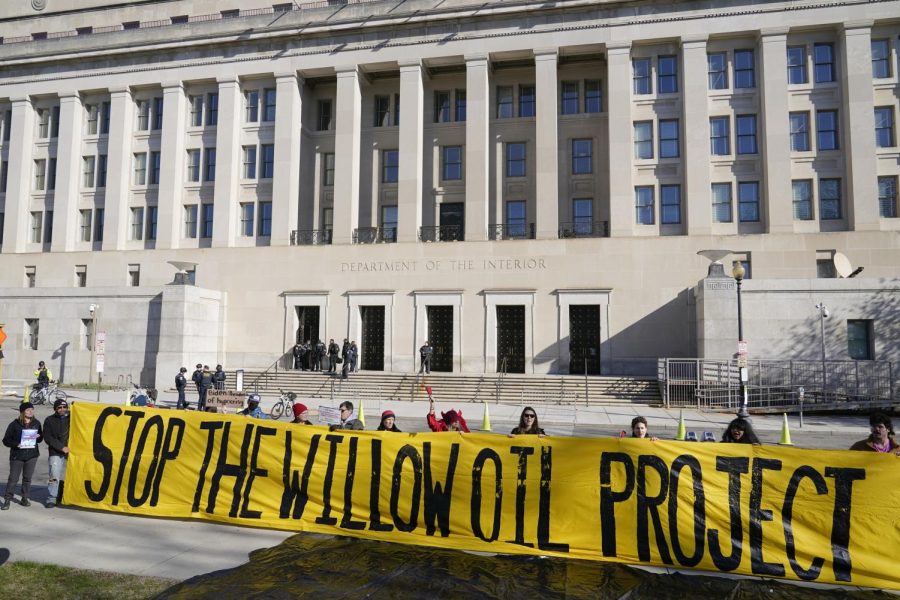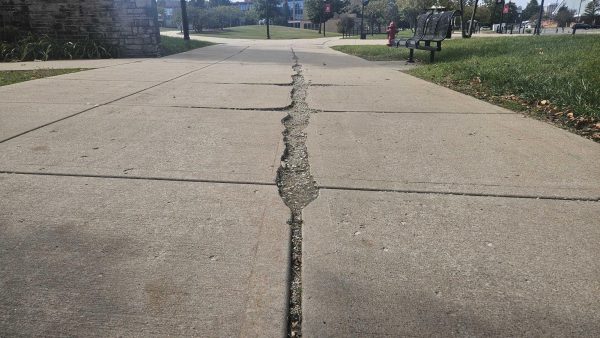Look Both Ways: The Willow Project
AP Photo/Patrick Semansky
Demonstraters protest against the Biden administration’s approval of the Willow oil-drilling project before a scheduled speech by Biden at the Department of the Interior in Washington, Tuesday, March 21, 2023. (AP Photo/Patrick Semansky)
ConocoPhillips’ Willow Project, a large-scale oil drilling project located in the National Petroleum Reserve on the North Slope of Alaska, was approved by the Biden administration on March 13.
Following this decision, a heated debate has ensued between the oil industry, Alaska native populations, environmental activists and working-class employees across the entire nation.
WHY THE PROJECT IS GOOD:
By Emily Beebe
Many people are concerned about the Willow Project in Alaska due to its environmental effects, but they do not consider the benefits that can result from it.
Although the Willow Project has very drastic and negative environmental effects, there is still some good that can come from this project.
According to MSN, the Willow Project can create jobs, generate income at the state and federal level and help the United States depend less on foreign oil.
It is better for us as a country if we can find other methods of getting oil and not have to rely on foreign oil as much, especially with the war between Russia and Ukraine.
The Willow Project can create over 2,500 construction jobs and approximately 300 long-term jobs, Fox Business reported. Even though unemployment is relatively low right now according to the U.S. Bureau of Labor Statistics, this is still very crucial, so that unemployment does not rise again.
According to the Department of Numbers, as of January 2023, the unemployment rate in Alaska was 3.8%. While this may not seem like a high percentage, this is about 28,000 Alaskans out of 731,545 that are unemployed.
Although the Willow Project is projected to have devastating effects on the environment, President Joe Biden is expected to announce restrictions on the project so that it will not be as damaging.
According to the New York Times, there are restrictions that could protect parts of the environment such as limiting future oil leases in the region, protecting more than 13 million acres from future drilling and also protecting habitats of animals such as polar bears.
The Willow Project can create some good in Alaska and the United States.
WHY THE PROJECT IS BAD:
The Willow Project is expected to produce 180,000 barrels of oil each day, according to ConocoPhillips’ plan. It will be the largest oil drilling project ever initiated in America and it will come with incredible consequences.
While much support for the project is justified – such as the jobs it will undoubtedly foster – it is difficult not to feel heartbroken. Ultimately, any benefits the Willow Project provides will not be worth such a major step backward in the fight to move away from fossil fuels.
With the rate that climate change is accelerating, most environmental experts acknowledge that we need to switch to renewable energy as quickly as possible. The U.S. remains the second highest emitter of carbon dioxide globally, according to research by Our World In Data, contributing 5.93 billion tons in 2021.
With the Willow Project, our nation only cements its dependence on the oil industry.
Unfortunately, the reality of the oil and gas industries’ huge economic presence in the U.S. prevents a large-scale switch from being plausible. Still, small steps – such as the quiet rising of the renewable energy industry – can and do have impact. Small steps are powerless, however, against a fossil fuel leap of this magnitude.
According to the Carnegie Endowment for International Peace, the project will pump 277 million tons of carbon dioxide into the atmosphere, which is equivalent to 4% of U.S. total annual emissions. Furthermore, the ecological impact will see species such as Northern caribou, polar bears and countless migratory birds put at risk.
Perhaps most crucially, the Native Village of Nuiqsut, the closest Indigenous Alaskan community to the Willow Project, fears the project will jeopardize their subsistence-style way of life. Among anyone we must listen to regarding this project, surely the people who will be so heavily impacted are the most important.














